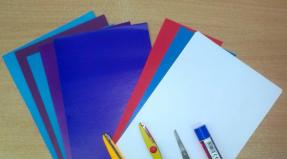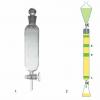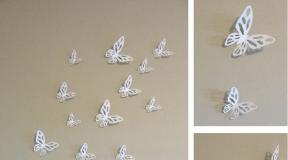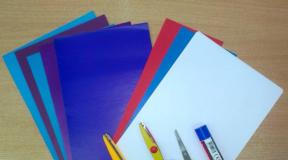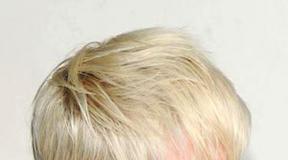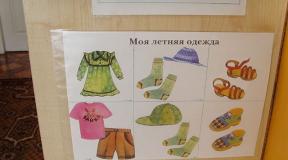Sea animals from beads patterns. How to make animals from beads? Correct reading of bead weaving patterns
Surely many of us have thought about how to use little things to add a special twist to our style, decorate the interior, how to cheer up a friend or colleague by giving him a small and cute gift, how to diversify a child’s leisure time while in line or on a trip. Everything is much simpler than it might seem at first glance. Cute little animals made from beads will help us with this. In this article we will look at weaving patterns
Where to use them?
The scope of use of small figures is very diverse. First of all, what comes to mind is a very unusual looking bundle guarded by a lion or a dog made of beads, isn’t it? And the neat little ones and the bears look amazing on the keys.

In addition, small figures look great as pendants. Most often, voluminous products are used for these purposes, attracting attention and uplifting the mood. Three-dimensional animals are also used to make brooches. Butterflies, ladybugs and dragonflies will unusually decorate a blouse or dress.
An excellent addition to the gift will be small wicker animals that will complement the present well. They will also fit well into the interior. In this case, the size of the product should be made larger.
Patterns for weaving animals from beads will help you create wonderful toys for children. With them they will have fun in a boring queue at the clinic or on a long car journey.

Materials for production
To make an animal from beads, you need:
- beads of selected colors (depending on the product);
- fishing line, wire or thread on which beads are strung;
- beading needle (for stitching the product);
- jewelry accessories (hooks, rings, etc.).
Most often, animal figurines are made of wire, so they hold their shape well.
In addition to the listed materials, you need to choose for yourself patterns for weaving the animals from beads that you will make. Without these schematic tips, a novice master can easily get confused in the stages of work.
Creating small figures
Often, patterns for weaving animals from beads for beginners are quite simple. They are not voluminous; most of the figures are made using parallel weaving. For example, the crocodile shown in the picture is created from green beads and wire (or fishing line). It will serve as an excellent keychain or bag pendant.
The technique creates legs that, as work progresses, are woven to the main fabric - the body. At the end of the work, we attach the selected accessories, and the cute crocodile is ready.

The next figure, an elephant, is created using a similar technique. Here the ears, trunk and tusks are woven, which are then organically woven into one whole. To create this product you will need beads of four colors.

A figurine of Tzipa the chicken would be an excellent pendant for a children's keychain. The separately made legs of the product are woven into the body without interrupting work. The main thing is to correctly alternate the colors of the beads to create eyes and a beak.

As you can see, this fascinating thing is bead weaving. Animal designs can be quite simple and the results are amazing.
Volumetric figures
This is a more complex type of beading that requires some skill. The fact is that such products need to be woven, carefully following the pattern so as not to go astray. Most often, circular weaving or parallel double-sided weaving predominates. The patterns for weaving three-dimensional animals with beads are quite intricate; only experienced craftsmen will not have problems with them.
As a rule, for small-volume figures, flat weaving of identical parts is used, which is sewn together at the end of the work. An example of such a scheme is shown in the figure.

This charming dolphin can become a decoration, souvenir or pendant. Cotton wool is often used to add volume. She stuffs herself inside. Then the finished product will not sag and will keep its shape perfectly for a long time.
Most three-dimensional figures, according to experienced craftsmen, are woven using similar techniques. They differ only in the shape of their paws, tail and head. But the body is created in approximately the same way in all animals. The picture shows a three-dimensional dog that can be made using the three-dimensional weaving technique.

Conclusion
Diverse is not only very unusual. They are also good because they can be made with your own hands, to your own taste and color. The size of the material and color scheme are chosen by the master in accordance with his taste. Much also depends on the pattern of weaving animals from beads. Regardless of the level of complexity of the patterns, the products turn out bright, memorable and fun.
Animals made of beads... They shine so beautifully in the sun, playing with all the colors of the rainbow. Who wouldn't want to have such a shiny miracle in their pocket? Make a three-dimensional figurine from beads, and a colored ray of light will always be with You.
To weave beaded animals you will need: multi-colored beads, thin wire and... a good mood.
And to make bead weaving easy and relaxed, look carefully animal diagrams. They will help you organize your work correctly. I have prepared for You a whole zoo of representatives of the fauna of our planet.
Cute elephant- a symbol of wisdom, strength and kindness. Give it to your best friend, and the animal will certainly bring him good luck.

Gorgeous-turtle will be a wonderful decoration for your mobile phone.

Volume bear made from beads is an excellent alternative to the famous one.

Welcome to the underwater kingdom! Gallant octopus will effectively decorate the collection of shells you brought from the sea.

Dangerous scorpion. Boys will definitely like this accessory.


Do you dream of your own parrot? A bright bird made of beads will make your dream one step closer. And fans of the cartoon “Rio” will certainly be delighted with the colorful parrot.

Proud peacock made of beads can become a real highlight of the interior.

How do you like the idea of making a cool keychain for a backpack in the shape of chanterelles?

Pink flamingo- a cool souvenir for a birthday, especially if the birthday boy dreams of it.

Smallsecret: if you want to make the animal larger, but are afraid of changes in the pattern, just choose larger beads, while the base should be stronger and thicker than the limbs. Then the proportions of the figure will be preserved, and the scheme will not need to be changed.
Weaving animal beads is an interesting and painstaking activity that requires attentiveness and perseverance, but the result will certainly please you. So if creativity, patience and ingenuity are your second “I”, quickly get to work: create animals from beads.
Weaving with beads- one of the ancient decorative and applied arts. Beadwork originated on the African continent, and today it is known throughout the world.
For beginners, bead weaving can open up unprecedented scope for creativity. You can see so much from the masters of this wonderful art: beaded trees, beaded toys, jewelry, decorative accessories for the home, and much, much more.
Flat and three-dimensional animals made of beads
Beginners are recommended to make crafts from beads according to ready-made patterns - this will help them not to make mistakes in counting beads and the sequence of techniques. Such bead weaving patterns can be intended for so-called 2D, i.e. flat, and 3D, i.e. volumetric, crafts. It is recommended to study from flat products.
|
|
|
|
|
|
Some of the favorite beading patterns for beginners are toy animal patterns. You can decorate your home or delight your children with such funny and beautiful toys. There are patterns for weaving animals with beads for beginners with different skill levels.
Weaving animals with beads and patterns for them for beginners
For example, you can weave a cute crocodile. To weave a product measuring 9x12 you will need 125 pieces of green beads, 150 yellow beads, 1 black, 2 bright (blue, red, etc.), fishing line. The required length of the fishing line is calculated based on the size of the beads. For large beads you will need 1.75 m of fishing line 0.25-0.3 mm. For medium-sized beads - 1.1 m of fishing line 0.2-0.25 mm.
The crocodile is made using the parallel weaving technique. To perform parallel weaving, beads of the first and second rows are strung onto the fishing line at once. Then one end of the working thread is passed through all the beads of the second row towards the other end. After this, both ends of the fishing line should be pulled thoroughly “all the way” so that all the beads are placed in the middle of the fishing line.
The complete pattern of weaving crocodile beads is presented below (Fig. 1).
In a similar way, i.e. Using the parallel weaving technique, you can also weave other funny animals - a turtle (Fig. 2), a dog (Fig. 3), and a spider (Fig. 4). If the product must keep its shape well (like, for example, a spider and its “legs”), then bead weaving is done on wire.
In our article we will tell you about one of the most wonderful types of hobbies - making animals from beads. It is perfect for those people who like to do slow and painstaking work. Crafts and animal figurines can be used as gifts for family and friends, or made for yourself and decorated with them at home.
The most important thing is preparation
The hobby itself is quite complex; there are many ways to weave animals and various figures. If you have never done bead weaving, then do not be afraid - we will start with one of the simplest weaving patterns. In our article we will talk about how you can make animals from beads. We'll start with a snake, and if you like it, we'll move on to more complex patterns using a turtle as an example.
How to make a snake from beads?
To get started, you will need:
- 1. A scattering of small beads of the same color (preferably green) - this will be the main color of our snake.
- 2. Two large black beads - they will be the eyes of the animal.
- 3. One small red bead - it will be the tongue of the snake.
- 4. Thin wire - this is what we will string all the beads on.
Once you have prepared all the components, you can proceed to familiarize yourself with the diagram:
- 1. Take and straighten the wire and start stringing several beads. You need to string them in the following sequence: one small (for example, green), one large black, two green, one red, again two green, black and again green. This way we were able to make the head of our snake.
- 2. In order to separate this part from the rest of the body, you will need to fold the wire together and string two small beads on them. You should end up with a rounded snake head.
- 3. So, we separated this part from the entire body. Now you can move on to creating the rest of the body. To begin, we will create several large segments, each of which will require 7 small beads. You need to separate two wires and string three balls onto each of them, then stretch them crosswise through the seventh, which must be placed perpendicular to the others. This will give you your first segment.
- 4. Repeat the procedure from the third point four more times. You should have five “rings”.
- 5. Once you get five pieces, you will have to reduce the segments a little. Now, to create each one, you need not seven, but five balls, and you will need to put two, not three, on the wire. You will need to create four of these small segments. Having finished with this, you can safely move on to the final stage of creating the animal - the tail.
- 6. Our snake will not be endless - it’s time to finish it. To begin with, you need to reduce the small segments and use only three beads to create them, you should make five such segments. After this, you should completely reduce the components to one bead and simply connect with wire (pulling its ends through the holes crosswise relative to each other) to make a long chain. You need to tie a beautiful bow at the end - the snake is ready.

















You may notice that the snake did not turn out very beautiful - there is no need to worry about this, because we used the simplest scheme for beginners. If you liked the process itself or, perhaps, you easily wove a figurine, then below we will present another diagram according to which you can make one of the animals - a turtle.
How to make a turtle from beads?
If you've always wanted a fun decoration for your dress or can't find a gift for a special occasion for a loved one, a beaded turtle is perfect for this. The only thing that can stop you is that for this you need to know the brick weaving method - without it you will not be able to weave such a turtle.
First, you should prepare. You will need:
- 1. One large bead, which we will use as the basis for the figurine.
- 2. Beads of two colors.
- 3. Two small black beads that we will use as eyes for the turtle.
- 4. Thin and strong white threads, thin wire or fishing line.
Once you have stocked up on everything you need, it’s time to move on to the fake itself:
- 1. First, you need to take a large bead and wrap a thread (or fishing line) around it several times.
- 2. Once you have done this, then begin to weave beads onto the bead using the brick weaving method. You need to make four rows of beads, one in each, making sure that the resulting pattern bends like a real shell.
- 3. Having finished making the shell, you can safely move on to the rest of the turtle. To do this, you need to take new threads (or fishing line) and beads of a different color. Let's start with the head.
- 4. We used white beads for this, although you can use any other color. The head will consist of three rows: 1) The first (closer to the shell) will include three white beads. 2) In the second row we will make eyes for the turtle, and therefore it will consist of two black beads and one white. 3) In the third row there will be only two white beads. If everything is done correctly, then you will get the head of a turtle.
- 5. Now it's time to move on to the rest of the turtle body. In order to make a ponytail you will need only one bead, and the paws will consist of two rows. In the first row (closer to the shell) you should have two beads, and in the second - only one. When you make the paws. Try to make them symmetrical; to do this, you can try them on “by eye” or simply count out the beads.







If you want, you can use a third color other than white for the paws. A pattern on a turtle shell will look great - for this you can use beads of expressive colors. To tie the beads together, we mainly used thread or thin wire, however, as an alternative, you can use fishing line, which is much stronger than thread, but thinner and easier to handle than wire.
As you can see, with the help of beads and imagination you can make a figurine of any animal. If you begin to engage in such a hobby, then over time you will be able to discover how far you have come in learning bead weaving - in the future you will be able to easily weave complex figures and use complex types of patterns and weaving for this. You can find many diagrams for different figures on the Internet.
Everyone ever thinks about how, using something small, to make their image unique and unusual, add comfort to the interior, please family and friends, or entertain a child on a free day. All of these seemingly complex issues have a very simple solution. Cute beaded animals can be an original and good solution. Schemes of animals made from beads will be very helpful in such work; we will consider them in this article.
Application options
There are a huge number of application methods for small models of beaded animals. The most common are key rings. Keys with a guard in the form of a lion or a dog will look very unusual and interesting. And the figures of cats and bear cubs will look very cute and cute.
The scope of use of small figures is very diverse. The first thing that comes to mind is key chains. A bundle guarded by a lion or a dog made of beads looks very unusual, doesn’t it? And small, neat figures of cats and bears look amazing on the keys.

Such animals also look good in the form of pendants. For this purpose, it is better to create voluminous products that will attract attention and create a mood.
Beaded animals can be used as brooches. Beautiful butterflies or dragonflies will look chic with blouses and add some flair. They can be used as a decorative element to decorate the main gift or as an interior detail if made larger. Using three-dimensional technology, you can create zoo toys for children, and they can also create animals with their own hands, because they are not difficult to make even for beginners.

Easy circuits
The following materials and tools will be required:
- Beads in colors matching the chosen animal;
- Fishing line, wire or thread;
- Beading needle;
- Accessories for the idea: hooks, rings, etc.
Most often, animal figures are made on wire, because it holds its shape well, or on fishing line. In addition to the above, you will also need a diagram for creating the selected animal. Without a schematic diagram, it will be easy for a beginner to get confused in the work.
We take a piece of fishing line, wire or thread up to a meter in size, depending on the chosen shape and size of the future animal. Fold the piece in half and secure it in the center with a pin; you can also use a hook for a keychain, as shown in the photo below. First, we thread the two ends of the fishing line through the first beads. However, keep in mind that all animals initially require a different number of beads in the initial row.

Below are several schematic images that will help you create flat beaded animals.
Funny frog:

Terrible lion cub:

Scary spider:

Hard working bee:

Cute turtle:
Beautiful butterfly:

Wise Owl:

Pink flamingo:
Bright parrot:

Playful little kangaroo:
Dear crocodile:

Cute kitten:

Ladybug:

Wonderful sheep:
Unusual lizard:

Interesting penguin:

Brave puppy:

Volumetric technology
Three-dimensional models of beaded animals can be used as toys, keychains, pendants, figurines and much more. Currently, a huge number of schemes and forms of three-dimensional animals have been invented. Let's look in detail, using a master class, on how to create a tiger cub using this technique.

Required materials and tools:
- Beads in brown, white, black and orange colors;
- Beads;
- Beading needle;
- Wire.
Such a tiger must be created using mosaic techniques.
First we will weave the tiger's cheeks. To do this, take the wire and collect a bead, fix it by threading the wire through it again. For the cheeks you will need white beads and two black beads. After creating two parts of the cheeks, we sew them together with a mosaic stitch.

We take fourteen brown beads and make a nose using mosaic weaving. Then we connect it to the cheeks.
Now we take orange beads and string them in a circle on both sides of the nose. We make four rows of pure orange beads, then add black beads, making the eyes of the tiger. Then we further weave the animal’s head in circles, alternately stringing black and orange beads, so tiger stripes appear.
After this, we take white and orange beads and, using square weaving, make ears. Each ear is made of two parts, white and orange, after which they need to be connected and braided in a circle with orange beads. We attach the completed ears to the tiger cub's head.
Using white beads, we create the lower jaw, on which we make a tongue from six red beads. Then we attach it to the head.

Using orange, white and black beads we weave the striped body for the tiger. After seventeen rows, we begin to reduce the number of beads from the sides, and then from the front. We make the body striped, and the tummy is white.
Now it's time to weave four paws for the tiger cub. We make sixteen rows and a sole, which we then connect to the paw with a mosaic seam. At the very end we make the tail. It looks like a square rope. All that remains is to connect all the made parts together, and a cute tiger cub will come out.
Video on the topic of the article
The schemes and techniques discussed above are far from the only ones; there are many more; for further development of skills, we offer below several more videos with lessons on creating different animals from beads.




